
by Lori Vande Krol | Mar 14, 2025 | General Productivity, Planning, Time Management, Tools
Time tracking may not be the most exciting task but taking a step back to reflect on how we spend our precious minutes and hours can be a game-changer. When we examine our daily routines, we gain clarity on where our time truly goes, helping us live more intentionally, enhance productivity, reduce procrastination, and reach our goals. Many of my clients have had eye-opening realizations—both big and small—after committing to just a week of time tracking and asking themselves a few simple but revealing questions. Below, I share some practical tips and tools to make time reflection a seamless part of your time management routine.
How to Get Started with Time Reflection
If you’re new to time tracking and reflection, start simple by looking back regularly throughout your day. Chris Bailey, author and Productivity Consultant, suggests the following in his recent blog: “…set a chime on your phone that’ll go off every hour or two. When it goes off, reflect: What did you spend the last hour or two doing? Was it a productive use of your time, attention, and energy?”
A more advanced technique for time tracking allows you to work “as normal” and then reflect and evaluate at the end of each day. Small changes then result in continuous and lasting improvement.
Try these simple steps:
1. Track Your Time: Spend at least a week capturing everything you do throughout the day. Note the activity, time spent, and whether or not the activity was planned or unplanned. Use a journal, spreadsheet, or download the free Time Log below.
2. After reflecting on your day, answer the following questions:
- What did I learn? For example, What tasks took longer than expected? What distracted me from my priorities? What activities provided the most value?
- What can I change?
- What actions will I take?
3. Identify Patterns: Look for trends and areas where you can optimize your schedule, delegate tasks, or eliminate time-wasting activities.
Tools to Make Time Tracking Easier
There are many tools available to help you track and reflect on your time more effectively. A few of these tools include:
- Toggl – A simple yet powerful time tracker for individuals and teams looking for a simple, intuitive interface.
- Clockify – A free tool for tracking time across multiple projects and people.
- RescueTime – Unlike manual trackers, RescueTime runs in the background and provides insights on where your time goes without needing to start or stop timers.
- The simplest…pen and paper! For a template capturing all of the steps mentioned above, click below for a free download.
If you use a paper planner, you might also consider using this to not only plan your time, but track it. One ProAction Planner user shared that she uses the scheduling section of each weekly layout to track her time.
Let me know in the comments below if you use other time-tracking tools or methods that you enjoy.
Making Time Reflection a Habit
To truly benefit from time reflection, make it a regular part of your routine. Set aside 5 minutes at the end of every day and 10-15 minutes at the end of each week to review your time logs and adjust your schedule and routines accordingly. The more consistent you are, the more insights you’ll gain, leading to continuous improvements in productivity and overall well-being.
Final Thoughts
In a recent article by Digital Marketing News, “experienced remote workers,” including myself, were asked to share our favorite time-tracking tip and tool for remote work. Refer to this insightful article for additional ideas and tracking tools. There are many valuable suggestions whether you work remotely or not.
Time is one of our most valuable resources, yet we often let it slip away unnoticed. Taking a step back to analyze how we actually spend our time can reveal inefficiencies, uncover hidden priorities, and highlight areas for improvement. By making time reflection a regular habit, you can gain greater control over your daily schedule and align your actions with your long-term goals. So, take a moment to look back—you might be surprised at how it propels you forward.

by Lori Vande Krol | Jan 9, 2025 | General Productivity, Goals and Priorities, Motivation, Planning, Team Productivity, Time Management
“What if a goal is unachievable?” This question came from an audience member during a recent goal-setting workshop I presented. I suspect she was referring to a goal assigned by her “higher-ups” at work – a goal she felt was unreasonable. Many of us, at some point, have likely felt similarly about personal or professional goals. My immediate response was, “But what if it is possible? What could happen if you actually reached that goal?” Before dismissing a goal as unattainable, it’s worth taking a step back and evaluating why it feels out of reach.
1. Know why the goal is important to achieve.
Without a good understanding of why a goal is important, it’s hard to drive passion and motivation towards achieving it. Ask yourself, “What is the ultimate purpose of this goal?” Understanding the “why” can help you stay focused and committed, even when the journey gets tough. This clarity often reveals where the goal aligns with larger organizational or personal values, making it easier to prioritize and tackle.
2. Review current and needed resources to achieve the goal.
Are there resource limitations that may hinder progress toward the goal? This evaluation should include people, time, money, tools, and technology. If the goal is truly unachievable using current resources, a case should be made for including needed resources in the plan for that goal. For example, if you lack the necessary expertise, consider seeking training or outsourcing. Similarly, if time constraints are an issue, reevaluate deadlines to ensure they are realistic and manageable. You might also look for ways to automate steps or work to create other efficiencies.
3. Get everyone in the boat and rowing the same direction.
Even if all of the people impacted by a goal know and understand the “why,” you may still have team members who disagree with the goal. A rowboat reaches the finish line only if all team members are rowing together in the same direction. Think how far and fast you can go if everyone is in sync and working together. To achieve this unity, foster open communication, address concerns, and ensure everyone feels heard and valued. When team members share a sense of ownership over the goal, they are more likely to contribute wholeheartedly.
4. Break the goal into smaller milestones.
Sometimes a goal feels unachievable because it seems overwhelming. Breaking it into smaller, actionable strategies and steps can make it more manageable. Each milestone achieved provides a sense of accomplishment and builds momentum toward the larger goal.
5. Evaluate potential obstacles and solutions.
Identify the barriers that make the goal seem out of reach. Are they external, like market conditions or budget constraints, or internal, like skill gaps or low morale? Once identified, brainstorm potential solutions or workarounds. This proactive approach transforms challenges into opportunities for innovation.
6. Be open to revisiting and redefining the goal.
While it’s essential to push boundaries, some goals might need to be adjusted to reflect reality. If, after thorough evaluation, a goal remains unattainable, consider redefining it. Adjusting the scope doesn’t mean failure; it’s about being strategic and focusing on what can realistically be accomplished while still striving for excellence.
Final Thoughts
Unachievable goals can feel daunting, but they also present opportunities for growth and innovation. By understanding the “why,” assessing resources, fostering team alignment, and adopting a strategic approach, you can turn seemingly impossible goals into achievable ones. Remember, the journey toward a goal often teaches us more than the destination itself. Even if you don’t fully achieve the goal, the progress made can set the stage for future success.
For a list of goalsetting resources, check out our prior blog: Goal Setting is Hard.
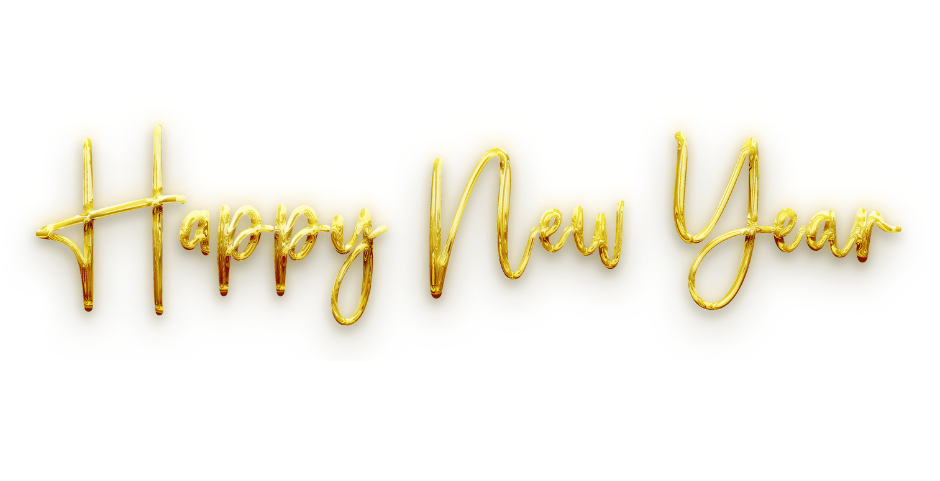
by Lori Vande Krol | Dec 27, 2024 | General Productivity, Goals and Priorities, Habits, Planning, Time Management
As 2024 comes to a close, it’s the perfect time to pause and reflect on the year. Looking back allows us to appreciate our achievements, learn from challenges, and set the stage for an even better year ahead. Here are a few questions to guide your reflection and help you prepare for a successful 2025:
- What did I accomplish this year? What am I most proud of? What victories, big or small, are worth celebrating?
- What actions contributed to my success this year? Which habits or strategies will I continue to build on?
- What were my biggest challenges? Were they avoidable? What can I do to prevent similar obstacles in the future?
- What will I do differently next year? What new actions or changes will I take to move forward?
- What is one specific area I can improve in 2025?
Now, grab your favorite notebook or journal, cozy up with a warm drink, and carve out some quiet time for self-reflection. This time is a gift — a chance to acknowledge your growth and set meaningful intentions for the year ahead.
Click here for a worksheet to support your Year in Review!

by Lori Vande Krol | Nov 20, 2023 | General Productivity, Goals and Priorities, Organization, Planning, Time Management, Tools
There is no question this is a busy time of year. But as we near the end of 2023, there are still a few things you can do to close out the year and prepare for a successful 2024.
1. Spend time on office “maintenance. Schedule a few days to catch up on filing, update your contact database, organize your receipts for the year (send them to Shoeboxed and let them take care of it for you!), empty your email inbox, and/or scan in those piles of paper (I recommend the Fujitsu ScanSnap iX1600 for PC or Mac for this task.) I like to use the last week of the year for these maintenance items. Spending some time to maintain your office productivity systems will help you feel you can start the New Year fresh and accomplish your goals.
2. Fill a bag for donation. Get a trash bag (or box depending on the type of items) and take 10-15 minutes to fill it with items to donate. Drop them off at a shelter, church, Goodwill, Salvation Army, or the charitable organization of your choice before the end of the year to receive your 2023 tax deduction. Help others that may not be as blessed during the holidays and clear out your space at the same time.
3. Crush what’s left of 2023. Plan the remainder of your year to help you prioritize and be intentional about how you want to spend this busy time. Brainstorm a list of personal and work tasks you want to accomplish before yearend. Be sure to review your 2023 goals to determine what is left to accomplish and determine if and how you will do so. Once you have a list of tasks, schedule them. With about 6 weeks remaining in the year, when will you focus on each task? Check out the ProAction Planner as a helpful tool for planning and scheduling.
4. Reflect on the year. Review the good and bad from 2023. What went well? Where did you find challenges? What will you continue doing, start doing, and/or stop doing in 2024? Download and complete our Year in Review Template, using the button below, to help you through the process.
5. Create your 2024 goals. Determine three to five goals for 2024. Why are these goals important? What strategies will you use to reach your goals? What tools or resources do you need to accomplish them? Check out our past blog, Goal Setting is Hard, for more goal-setting tips.
While each of these takes some time and focus, the value received is well worth it. Be sure to schedule them in before your end-of-year calendar is full.
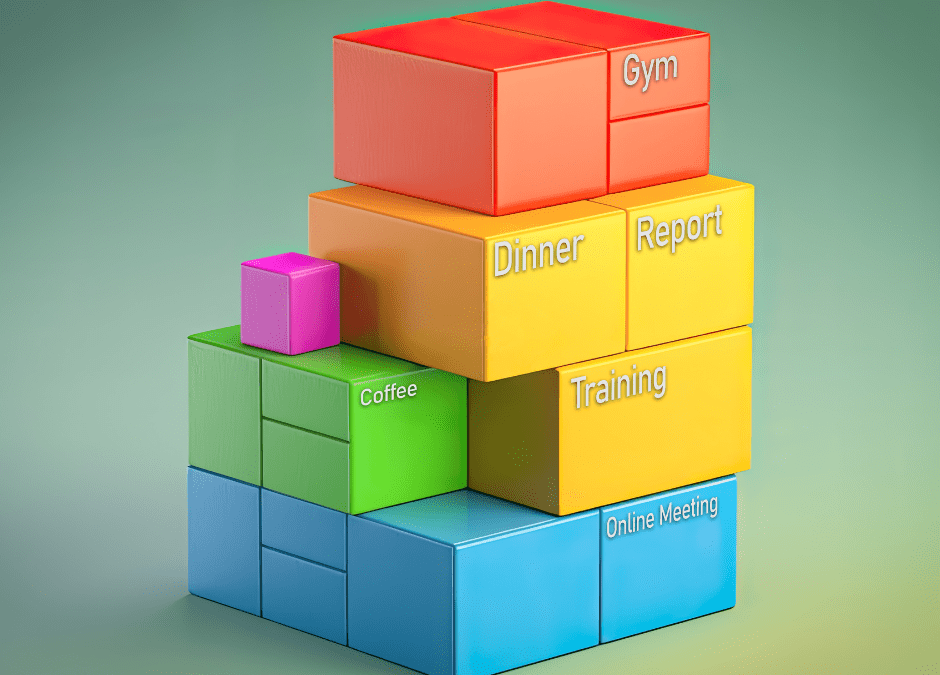
by Lori Vande Krol | Sep 7, 2023 | Goals and Priorities, Habits, Planning, Time Management, Tools
“I’ve tried time blocking in the past and it’s never worked for me.”
This was a recent statement from a client who I was helping with time management. Once we dug in more, we found it wasn’t that time blocking was an ineffective method, but that it wasn’t being applied in the most ideal way for him. This isn’t an uncommon complaint. In fact, even David Allen, productivity guru and author of Getting Things Done, used to argue against time blocking. He preferred a simple calendar with only the necessary appointments and deadlines. But eventually, he realized time blocking can work well for many people and even began practicing it himself.
Let’s dive a little deeper into what time blocking is, who can benefit (*hint* – everyone!), and how it might work best for you. I also share tips, tools, and resources to support your time-blocking habits.
Wikipedia defines Time Blocking as:
“A productivity technique for personal time management where a period of time—typically a day or week—is divided into smaller segments or blocks for specific tasks or to-dos. It integrates the function of a calendar with that of a to-do list. It is a kind of scheduling.”
While I agree with this definition of time blocking, there is much more to it than this.
Who should use a time-blocking technique?
Time blocking is best used for people who:
- Have a busy schedule and need to be very intentional about how they use their time,
- Have a fairly open schedule that can be wasted away if time is not blocked to work on specific tasks and projects (aka Parkinson’s Law),
- Reach the end of a day or week feeling stressed and unaccomplished, wondering where the time went,
- Juggle multiple areas of work and life,
- Struggle to find time for focus and big-picture thinking,
- Deal with constant interruptions, or
- Spend too much time “reacting” to the day’s urgencies.
If we are honest, isn’t this all of us at one point or another? I believe that some form of time blocking can work for almost everyone. The key is finding the method, or combination of methods, that works best for you.
Types of Time Blockers
While there are many different ways to apply time blocking to your calendar, we can simplify it by looking at three key methodologies.
1. The Serious Blocker divides their day into specific blocks of time, each dedicated to accomplishing a specific task, or group of tasks. They start each day, or week, with a concrete schedule that lays out what they will work on and when. A serious blocker will work to bunch related tasks (i.e. “task batching”) such as email processing, social media creation, or phone calls, into one block.
In addition, the serious blocker lumps meetings together. That way, they can spend larger chunks of time on focused projects and tasks versus shorter amounts of time spread between meetings throughout the day. This type of time blocking requires more work upfront, and potential cooperation from others, to reschedule meetings that will better fit your ideal schedule.
2. The Flexible Blocker applies time blocking in a broader way, with more general blocks that are flexible depending on what comes up throughout the day. This works well when your days are less predictable and require a more “reactive” approach (e.g. a customer service specialist). Some argue that these types of schedules aren’t compatible with time blocking, but when your workday is often run by outside forces, it’s easy to lose sight of your own goals. Even a simple version of time blocking can help you gain a greater sense of control over unpredictable schedules. You can still block off time for your “reactive work,” and then be more intentional about time during the day that allows for some planning and control (regardless of how little).
3. The Time Themer chooses themes for work they will do during certain time blocks. This is the most open-ended version of time blocking. “Day theming” is the most popular example where you choose a theme for each day of the week. For example: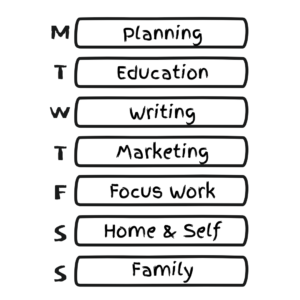
Any open time is spent on that day’s area of focus. Day theming minimizes the choices you need to make about what to work on throughout the day. You look to your theme and choose tasks based on that theme.
You can also use time theming to break up your day by assigning themes to blocks of time throughout the day. An example of this would be: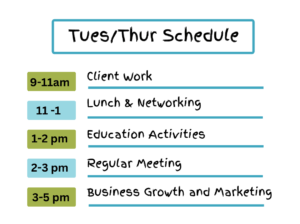 The schedule may be the same every day or may differ throughout the week. In the example above, Tuesday and Thursday have the same “themed schedule” while the other days look different. In the resources section below I share a template called My Productive Week that can be of great assistance in defining your daily “theme blocks.”
The schedule may be the same every day or may differ throughout the week. In the example above, Tuesday and Thursday have the same “themed schedule” while the other days look different. In the resources section below I share a template called My Productive Week that can be of great assistance in defining your daily “theme blocks.”
Most people do not fit perfectly into one time theming option but instead use a combination. For example, having a schedule of daily themes can make it easier to determine what tasks to put into working time blocks when using the “serious” or “flexible” blocking methods.
The Benefits of Time Blocking
While it takes some work, and potentially a change in mindset, the following benefits of time blocking show the value of this time management methodology.
- Your need to make decisions at every point in time throughout the day is minimized because your schedule is pre-defined. This saves time and energy throughout your week.
- If you get easily distracted or off-track, a time-blocked calendar will help to pull you back into focus. In addition, time blocking helps to fight multi-tasking allowing you to focus all of your energy on one thing at a time.
- You will get more realistic about how long things take. We often underestimate the time tasks and activities take, and this is a concrete way to see that. This will get better over time.
- When you see your priorities laid out in your finite calendar, you can more easily say “no” to those things that don’t fit.
- You are more likely to accomplish your goals if you schedule specific, intentional time to work on them.
- It will be easier to relax during your leisure time as you know you have a plan to get everything done.
“A 40 hour time-blocked work week, I estimate, produces the same amount of output as a 60+ hour work week pursued without structure.”
– Cal Newport, Author of Deep Work –
Tips for Effective Time Blocking
Below are key things to consider when working to design and maintain your own time-blocking routine.
- Build your time-blocking methodology into regular weekly planning. Look at your upcoming schedule, deadlines, and tasks and fit it all together to create a week that takes into account your goals, priorities, and commitments.
- Review your schedule daily and reset your week as necessary.
- Your routines and habits should be incorporated into your time blocks.
- Leave a time block for an overflow of tasks that take longer than expected or for unexpected appointments or to-dos that come up during the week.
- Once your week is planned, make intentional choices when straying from that plan.
- Leave space between, or within, blocks for transition, travel, time, and necessary breaks.
- Bunch your urgent but less important work together and dedicate a pre-determined amount of time to it. This allows for longer, uninterrupted time for focused work.
- Consider your daily rhythms in your schedule. When are you most energetic, productive, or focused?
- Evaluate your time-blocking schedule regularly and make needed changes.
- When scheduling time blocks for focused work, find a quiet location free of interruptions and/or block notifications on your computer and phone.
- Consider whether you want to block time on weekends (or other non-working days). You may want to leave these times open to allow freedom and flexibility with leisure time.
Most importantly, remember your time-blocked schedule is a guide to assist you with creating your most productive week. If you try to stick to it perfectly, especially at first, you will get overwhelmed when things come up that cause needed changes to your schedule. Review, reset with intentional decisions, and move forward. You might look at time blocking as a game or a puzzle. How can I fit it all in the most optimal way? But as with any game, you will make mistakes, learn along the way, and get better with practice.
Time Blocking Resources
The following resources can help you create your own time-blocked schedule.
- My Productive Week Template
I have created this tool as a template to build your “puzzle” for your time-blocked weekly calendar. It is to be used as a guide – along with your weekly schedule, goals, and tasks – for your weekly planning. The template can be completed digitally or printed.
- The ProAction Planner:
If you prefer to do your weekly planning with a paper planner, which allows for better mental processing and decision-making, the ProAction Planner is a tool to support all of the important areas of planning and time management. A paper planner provides an easy visual that stays in front of you throughout your day. If using a paper planner, I recommend using a writing instrument that allows for change throughout the week. My tool of choice is the Frixion Clicker Erasable Gel Pen, in multiple colors.
- Online Calendar (Outlook, Google, Other)
Whether or not you use a paper planner for weekly planning, the majority of us use an online calendar to keep track of our meetings and appointments. If you choose to use an online calendar for time-blocking, consider color-coding the blocks of time you wish to be flexible. I like to color my movable time blocks with yellow and mark them as “free.” Also consider those time blocks that you want to protect, mark them as busy, and consider them a meeting with yourself.
- Pomodoro Technique and Tools
The Pomodoro Technique is a method in which you focus for timed periods with short breaks between blocks. Learn more about this technique on their website and search for apps like this one to support the technique.
If you are interested in some assistance in determining and implementing the right time-blocking solution for you, please reach out. I’d love to help.

by Lori Vande Krol | Feb 6, 2023 | General Productivity, Goals and Priorities, Habits, Planning, Time Management
Julie reached out because she had reached a point of extreme frustration and overwhelm. She felt she was constantly trying to catch up, never finding time for her “important but nonurgent” tasks and projects, always worried about what she might be missing, and therefore not truly enjoying her work or personal time. Julie was always reacting to the latest emergency, others’ priorities become her priorities, and she would reach the end of the day, the week, and the year feeling drained, overwhelmed, and unaccomplished. Does this sound familiar?
After talking with Julie, we established that one change she needed was to incorporate a better system and tools for planning her time – her years, months, weeks, and days. An effective plan, and strategy to follow and maintain it, allows Julie to better understand her goals and priorities, and to make better decisions and choices throughout her days. Here I share ten proven strategies for incorporating effective planning into your own days and weeks.
1. Clarify your goals and priorities.
What is important to you in work and life? What do you hope to achieve in the long-term and short-term? If you aren’t clear on what your goals and priorities are, you can never know if you are working on the right thing at any point in time. This clarity will be the basis for your plan and the choices you make throughout the day.
2. Break down your goals into strategies and milestones.
As an elephant lover, I hate to use the saying “How do you eat an elephant? One bite at a time.” But it is a good metaphor for attacking your long-term and short-term goals. Once you know what you want to accomplish, you can break your goals into smaller pieces by defining the strategies you will use and when you will achieve various milestones.
3. Create your habits and routines.
Without good habits and routines, it is easy to let your days and weeks slip away without focusing on what is most important. Spend some time figuring out how you will incorporate the needed activities and time to reach your goals. List the habits you want to follow annually, monthly, weekly, and daily. Define daily routines such as tasks or actions you will take each morning, start of day, end of day, and evening.
4. Establish your boundaries.
It is likely that you will need to establish new boundaries in order to be successful in reaching your goals and sticking with your plan. Some examples might include:
- I will return emails and phone calls within 24 hours.
- I will take 1 day to review any new priorities, tasks, or projects before providing an answer.
- I will say “no” to anything that does not support my annual goals.
- I will not take on new volunteer positions this year.
- I will not respond to email or text after 6pm or on weekends.
- I will be in bed by 11pm and up by 7am each day.
Choose boundaries that work for your needs and personality and that will help you to reach your goals.
5. Get the right people on board.
Who will be impacted by your goals, strategies, habits, and routines? Do you have someone to help hold you accountable? Who can help support your plan? Be sure these people are aware of your plan, your boundaries, and how they can help you be successful.
6. Clear your space and your mind.
Take time regularly to clear your physical, digital, and mental space. If necessary, set aside a day or more to create an environment where you can focus and be intentional.
7. Determine the right tools.
What tools can you use to support your planning, focus, and daily intention and action? My favorite tools for daily and weekly planning are Microsoft Outlook/Tasks and the ProAction Planner. Do your research and find tools that will allow you to plan, reflect, track, and maintain. When working with others, it is also important to implement tools that will help you plan, collaborate, and track projects and tasks with them. Examples include Microsoft Planner and Teams, Asana, Trello, and Google Workspace. These are just a few of the many options available. Be sure to determine your needs and find what will best fit those needs.
8. Plan your weeks and days.
Set aside time regularly to plan your weeks and days based on your annual goals, habits, routines, and other priorities. Block time for the important, but nonurgent, projects and tasks. While it is rare that your week will go exactly as planned, having this basis as you begin your week will provide control and perspective, and allow you to make better-informed decisions when new urgencies arise.
9. Track.
Incorporate a system to track progress on your projects, goals, and habits. Review this regularly in order to evaluate and reset as needed throughout the year. You might also consider a look at how you spend your time and how closely you stick to your plan. Each day, evaluate challenges and areas for improvement. Small changes can yield big results.
10. Reflect and improve.
In addition to tracking your progress, schedule regular time to reflect on your results in order to make appropriate adjustments and allow for continuous improvement. This might include a quick daily and/or weekly reflection, a more thoughtful monthly reflection, and a deeper annual review and reflection. What went well? What challenges did you face? What will you stop, start, or continue doing? This is also a great time to practice gratitude. Be kind to yourself and others.
After clarifying her goals and priorities and putting the systems above in place to fit her needs, work, and lifestyle, Julie is feeling much more in control of her time. She is living intentionally and working proactively which has reduced stress and overwhelm. But the biggest and best change is that Julie is enjoying her work again and is able to focus on those people and things that matter most in life.
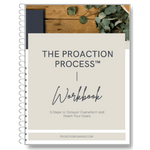
Need some tools to assist with the areas above? Check out our new ProAction Process™ Workbook packed full of tips, templates, worksheets, and exercises to support these areas of planning and more.
If you’d like a partner in helping you address your overwhelm and reach your goals, I’d love to talk. Reach out or schedule your free 30-minute consultation.

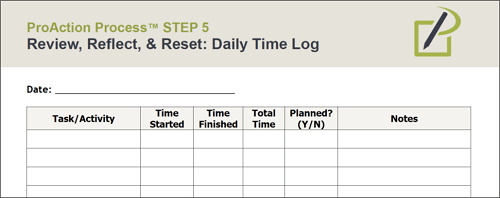






 The schedule may be the same every day or may differ throughout the week. In the example above, Tuesday and Thursday have the same “themed schedule” while the other days look different. In the resources section below I share a template called My Productive Week that can be of great assistance in defining your daily “theme blocks.”
The schedule may be the same every day or may differ throughout the week. In the example above, Tuesday and Thursday have the same “themed schedule” while the other days look different. In the resources section below I share a template called My Productive Week that can be of great assistance in defining your daily “theme blocks.”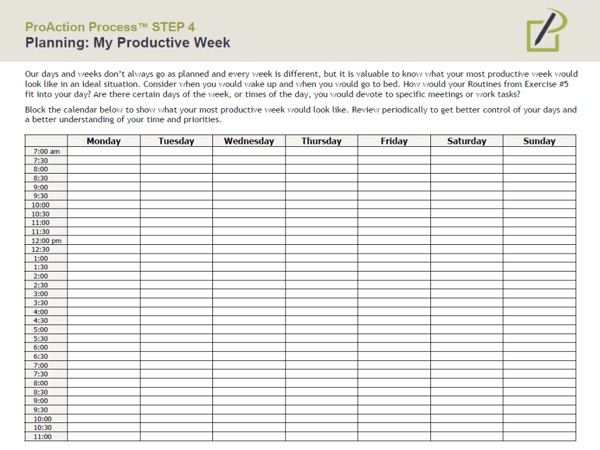


Recent Comments